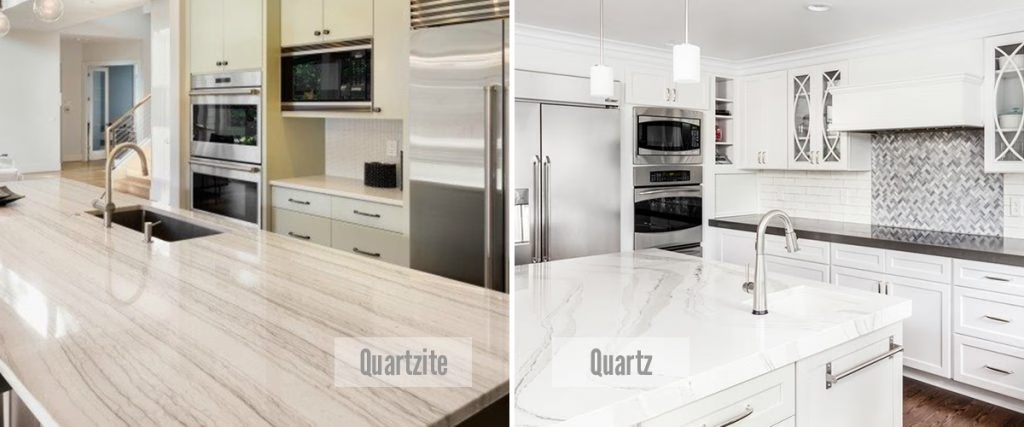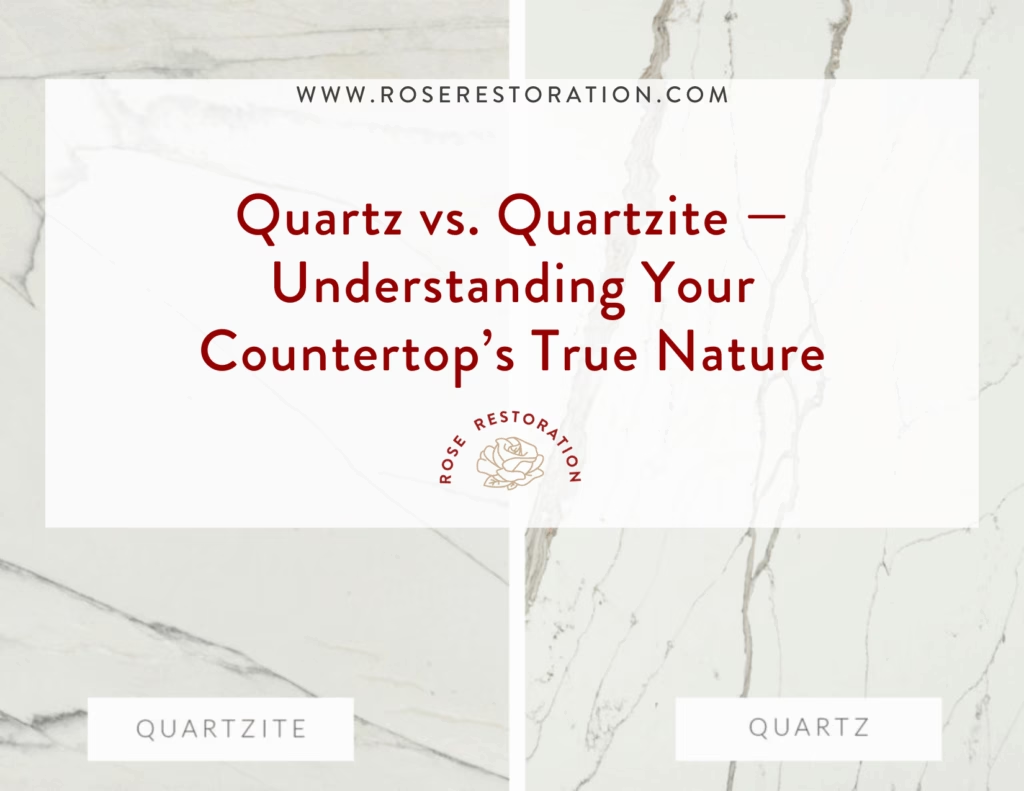Quartz and quartzite may sound alike, but their differences are critical when it comes to cleaning, care, and restoration. One is natural stone, the other engineered — and misunderstanding which you have can lead to costly mistakes.
At Rose Restoration, we help homeowners and property managers identify their surfaces and deliver the right countertop restoration approach for each. Here’s how to tell them apart — and what that means for ongoing maintenance, sealing, and repair.
🔍 Quartz vs. Quartzite at a Glance
| Feature | Quartzite | Quartz |
|---|---|---|
| Type | Natural metamorphic stone | Engineered (crushed stone + resin) |
| Appearance | Natural veining, unique patterns | Uniform color and pattern |
| Can Be Polished? | Yes | Limited |
| Etch-Resistant | No | Usually, but not always |
| Can Be Repaired | Yes | Sometimes |
| Needs Sealing | Yes | No |
| Maintenance Level | Moderate | Low |
Quartzite: Natural Beauty with Real Character
Quartzite forms when sandstone undergoes intense heat and pressure deep within the earth, creating a dense and durable natural stone surface. Its veining often resembles marble but with greater hardness and structure.
Best For:
High-end kitchens and vanities
Decorative floors or tabletops
Homeowners seeking a natural aesthetic with more durability than marble
Why It Matters:
Though tougher than marble, quartzite remains vulnerable to etching (acid damage) and staining. That’s why it needs periodic professional quartzite polishing, cleaning, and stone sealing to preserve its natural clarity and luster.
What to Expect After Service:
Restored clarity and color vibrancy
Reduced visibility of etching and fine scratches
Smooth, sealed surface with renewed sheen
Quartz: The Engineered Alternative
Quartz countertops are engineered stone surfaces crafted from ground quartz crystals and resins, molded into uniform slabs. Often marketed as “the beauty of marble with the durability of granite,” quartz offers consistent appearance and reduced maintenance — but not all quartz is created equal.
Modern Challenge:
Many newer, lower-cost quartz products include crushed marble filler, reintroducing calcium into the mix. This makes them vulnerable to the same acid etching and discoloration seen in natural stone.
Our Approach:
Quartz can’t be honed or polished like marble — its resin reacts differently to heat and friction. At Rose Restoration, we use specialized high-grit quartz diamonds, engineered surface repair techniques, and precision patching to restore shine and correct flaws without damaging the resin layer.
Best For:
Kitchens, bathrooms, and commercial countertops
Surfaces needing chip, seam, or haze correction
Clients seeking a low-maintenance engineered surface
Quick Guide: Common Surface Issues
| Issue | What It Means | Seen On |
|---|---|---|
| Etching | Dull marks from acidic spills | Marble, quartzite, some quartz |
| Staining | Discoloration from oils or liquids | All stone and porous surfaces |
| Scratches | Light surface grooves | Stone, quartz, quartzite |
| Dullness | Loss of gloss or reflection | Quartzite, polished stone |
Why It Matters
Both materials are long-lasting, but they age differently:
Quartzite needs sealing to prevent staining and moisture absorption.
Quartz doesn’t require sealing but can discolor or haze from UV light or chemical cleaners.
Knowing the difference ensures your surfaces receive the right countertop care plan.
Our technicians test, identify, and explain your surface type before recommending quartz restoration or quartzite repair and sealing.
What to Expect After Service
Renewed surface clarity and reflection
Reduced appearance of scratches, haze, and dull patches
Safe, even finish without chemical or heat damage
Transparent communication about what’s achievable for your surface type
Client Example
“A homeowner in Fairfax had a quartz countertop that developed cloudy spots after using bleach. Our technicians used high-grit quartz diamonds to resurface and restore the finish — no replacement needed, saving time and cost.”
FAQs: Quartz vs. Quartzite
How do I tell whether I have quartz or quartzite?
If your surface has consistent color and pattern, it’s likely quartz. Veining or natural variation usually means quartzite. When in doubt, Rose Restoration can confirm on-site.
Can quartz be polished like marble?
No — quartz can be resurfaced with specialized quartz polishing tools, but not polished like stone. Using marble pads can damage the resin layer.
Does quartzite always need sealing?
Yes. Quartzite sealing prevents staining, protects from moisture, and maintains the stone’s natural finish.
Recommended Maintenance Schedule
Residential Quartzite: Clean, Hone & Seal every 18–24 months
Residential Quartz: Deep clean and surface refresh every 3–5 years
Commercial Quartz or Quartzite: Annual professional maintenance for high-traffic use
Final Thoughts
Quartz and quartzite may share a name, but their care isn’t interchangeable. Understanding their unique properties ensures your investment stays beautiful and protected for years.
Whether you have engineered quartz countertops or natural quartzite floors, Rose Restoration provides specialized cleaning, repair, and sealing services that keep your surfaces performing — and shining — like new.
Contact Rose Restoration today for a professional countertop evaluation. Our experts will identify your material, explain the right treatment plan, and restore your surface with precision and care.


